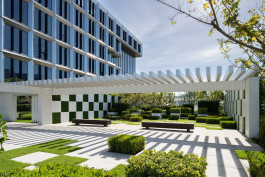Forbidden Fruit: Curiosity and Caution at the intersection of AI and Gardens
January 9, 2025
To create gardens for the world’s first purpose-built AI laboratory in Shanghai, Ballistic Architecture Machine (BAM) looked to the first archetype of all gardens: Eden. The astonishing ascent of artificial intelligence casts the biblical parable of forbidden knowledge in a contemporary light. At the apex of the laboratory, a rooftop garden offers a modern Edenic allegory, serving as a cautionary tale of knowledge’s paradoxical nature: the promise of wisdom and the peril of overreach.
The rooftop garden’s dialectic of contrasting conditions sets the tone for the WLA AI Lab’s multi-level landscape, exploring the hierarchy of intelligence—from data and information to knowledge and wisdom. The gardens throughout the levels of the laboratory complex offer perspectives on knowledge and its limits, challenging researchers to consider the ethical boundaries in their pursuit of innovation.
At the ground level, the gardens visualize the clash between raw information and the man-made analytical structures. Here, wind flow modeling derived from historical site data informs a microclimate-sensitive landscape that expresses the site’s persistent winds. Dynamic paving patterns compress where wind speeds peak, and kinetic installations, such as the Wind Wand, give physical form to the invisible force of nature. Inscribed with Confucius’s aphorism, “To learn without thinking is blindness; to think without learning is idleness,” the Wind Wand acts as a wind-reading device but also questions the merits of purely analytical thinking, prompting researchers to balance analysis with curiosity, practicality, and intuition.
On the third floor, BAM presents two opposing gardens connected by a cherry tree-lined path, embodying the coexistence of outward-focused collaboration and inward-oriented reflection. One garden, a public forum shaded by an aluminum canopy, provides a stage for human interaction, a space where ideas and achievements take form in shared dialogue. As part of this space, the ‘blue room’ art installation transforms vents into a tribute to pioneers of artificial intelligence, projecting glitch-like images. In contrast, the adjacent proto-Zen Garden rendered in overtly technological materials, offers a sanctuary of introspection. Its sound-dampening walls take the form of a three-dimensional grid, floating from the architecture into the garden, superimposed over the naturalistic landscape with two benches beneath a canopy shade.
At the apex of the building, the rooftop garden encapsulates the cautionary tale of the pursuit of knowledge, with wisdom as its pinnacle. A ‘thinking loop’ path winds between data servers through a pixelated desert landscape of yuccas and cacti, leading researchers to the Edenic oasis garden room. Sheltered beneath the photovoltaic panels of the roof, a selection of subtropical fruit plants creates a lush garden space, furnished with two Edenic Adirondack chairs for lounging amidst the luxurious foliage. The allegorical relationship between human knowledge and biblical myth forms the ultimate meditation for our researchers of machine intelligence.
From the raw clash of data and man-made frameworks at the ground level, through the interplay of collaboration and solitary contemplation at the mid-level, to the allegorical rooftop oasis, the gardens invite researchers to ascend through a hierarchy of thought—culminating in a confrontation with the ethical boundaries of their work.
A fundamental question that arose during the development of the AI Lab Gardens was whether to incorporate artificial intelligence tools directly into the design process itself. “We deliberately chose to avoid using contemporary tools like ChatGPT or Midjourney,” explains Wang Zixian, concept design lead at BAM. BAM’s decision to use manual design methods results in a design that emphasizes tactile experience and emotional resonance over algorithmic efficiency. “That’s not to say we rejected technology altogether; we engaged computation and digital modeling, but we did so in a systematic, building-block manner, without relying on scripts or parametric design models,” adds Wang.
“In our case, we hope that our gardens not only create intellectually stimulating and soothing environments conducive to innovative research but also push the researchers to explore the profound connection between humanity and our pursuit of knowledge,” says Dan Gass, co-founder of BAM. In China, where gardens are collectively understood as a cultural medium, BAM’s landscape design embeds layers of meaning that pose timely questions and exclamation points to ponder over, much like landscapes throughout the history have explored the balance between naturalism and abstraction. Today’s gardens speak to the evolving relationships of humanity, technology, and the environment, presenting a narrative that is as relevant as it is consequential.
Forbidden Fruit: Curiosity and Caution at the intersection of AI and Gardens
January 9, 2025
To create gardens for the world’s first purpose-built AI laboratory in Shanghai, Ballistic Architecture Machine (BAM) looked to the first archetype of all gardens: Eden. The astonishing ascent of artificial intelligence casts the biblical parable of forbidden knowledge in a contemporary light. At the apex of the laboratory, a rooftop garden offers a modern Edenic allegory, serving as a cautionary tale of knowledge’s paradoxical nature: the promise of wisdom and the peril of overreach.
The rooftop garden’s dialectic of contrasting conditions sets the tone for the WLA AI Lab’s multi-level landscape, exploring the hierarchy of intelligence—from data and information to knowledge and wisdom. The gardens throughout the levels of the laboratory complex offer perspectives on knowledge and its limits, challenging researchers to consider the ethical boundaries in their pursuit of innovation.
At the ground level, the gardens visualize the clash between raw information and the man-made analytical structures. Here, wind flow modeling derived from historical site data informs a microclimate-sensitive landscape that expresses the site’s persistent winds. Dynamic paving patterns compress where wind speeds peak, and kinetic installations, such as the Wind Wand, give physical form to the invisible force of nature. Inscribed with Confucius’s aphorism, “To learn without thinking is blindness; to think without learning is idleness,” the Wind Wand acts as a wind-reading device but also questions the merits of purely analytical thinking, prompting researchers to balance analysis with curiosity, practicality, and intuition.
On the third floor, BAM presents two opposing gardens connected by a cherry tree-lined path, embodying the coexistence of outward-focused collaboration and inward-oriented reflection. One garden, a public forum shaded by an aluminum canopy, provides a stage for human interaction, a space where ideas and achievements take form in shared dialogue. As part of this space, the ‘blue room’ art installation transforms vents into a tribute to pioneers of artificial intelligence, projecting glitch-like images. In contrast, the adjacent proto-Zen Garden rendered in overtly technological materials, offers a sanctuary of introspection. Its sound-dampening walls take the form of a three-dimensional grid, floating from the architecture into the garden, superimposed over the naturalistic landscape with two benches beneath a canopy shade.
At the apex of the building, the rooftop garden encapsulates the cautionary tale of the pursuit of knowledge, with wisdom as its pinnacle. A ‘thinking loop’ path winds between data servers through a pixelated desert landscape of yuccas and cacti, leading researchers to the Edenic oasis garden room. Sheltered beneath the photovoltaic panels of the roof, a selection of subtropical fruit plants creates a lush garden space, furnished with two Edenic Adirondack chairs for lounging amidst the luxurious foliage. The allegorical relationship between human knowledge and biblical myth forms the ultimate meditation for our researchers of machine intelligence.
From the raw clash of data and man-made frameworks at the ground level, through the interplay of collaboration and solitary contemplation at the mid-level, to the allegorical rooftop oasis, the gardens invite researchers to ascend through a hierarchy of thought—culminating in a confrontation with the ethical boundaries of their work.
A fundamental question that arose during the development of the AI Lab Gardens was whether to incorporate artificial intelligence tools directly into the design process itself. “We deliberately chose to avoid using contemporary tools like ChatGPT or Midjourney,” explains Wang Zixian, concept design lead at BAM. BAM’s decision to use manual design methods results in a design that emphasizes tactile experience and emotional resonance over algorithmic efficiency. “That’s not to say we rejected technology altogether; we engaged computation and digital modeling, but we did so in a systematic, building-block manner, without relying on scripts or parametric design models,” adds Wang.
“In our case, we hope that our gardens not only create intellectually stimulating and soothing environments conducive to innovative research but also push the researchers to explore the profound connection between humanity and our pursuit of knowledge,” says Dan Gass, co-founder of BAM. In China, where gardens are collectively understood as a cultural medium, BAM’s landscape design embeds layers of meaning that pose timely questions and exclamation points to ponder over, much like landscapes throughout the history have explored the balance between naturalism and abstraction. Today’s gardens speak to the evolving relationships of humanity, technology, and the environment, presenting a narrative that is as relevant as it is consequential.



